Description
Kinase Inhibitors, 2012
Methods and Protocols
Methods in Molecular Biology Series, Vol. 795
Coordinator: Kuster Bernhard
Language: English
Subject for Kinase Inhibitors:
Publication date: 08-2016
Support: Print on demand
Publication date: 09-2011
256 p. · 17.8x25.4 cm · Hardback
Description
/li>Contents
/li>Comment
/li>
Protein and lipid kinases are often the master regulators of cell signaling in eukaryotic systems. The human genome codes for more than 500 of these enzymes and their misregulation has been shown to be involved in the onset and progression of many diseases including cancer and inflammation. Therefore, small molecule kinase inhibitors have become important research tools for the elucidation of the many biological roles of kinases and their mechanisms of action. Kinase inhibitors thus also contribute significantly to the drug pipelines of the pharmaceutical and biotechnology industries and to the growing need to treat cancer and inflammation. In Kinase Inhibitors: Methods and Protocols, experts in kinase biology, drug discovery, and clinical research present a series of exemplary methods that can be used to address the many challenges facing scientists in the discovery and development of kinase inhibitors both for research and clinical use. Written in the highly successful Methods in Molecular Biology? series format, chapters contain introductions to their respective topics, lists of the necessary materials and reagents, step-by-step, readily reproducible laboratory protocols, and notes on troubleshooting and avoiding known pitfalls.
Authoritative and accessible, Kinase Inhibitors: Methods and Protocols aims to provide scientists with modern and relevant methods to accelerate or strengthen their research and drug discovery programs through the utilization of these vital regulators.
Targeting Cancer with Small Molecular Weight Kinase Inhibitors.- Small Molecule Protein and Lipid Kinase Inhibitors in Inflammation and Specific Models for their Evaluation.- Measuring the Activity of Leucine Rich Repeat Kinase 2 (LRRK2) – A Kinase Involved in Parkinson’s Disease.- Measuring PI3K Lipid Kinase Activity.- A Fluorescence Polarization Assay for the Discovery of Inhibitors of the Polo-box Domain of Polo-like Kinase 1.- Assessment of Hepatotoxicity Potential of Drug Candidate Molecules Including Kinase Inhibitors by Hepatocyte Imaging Assay Technology and Bile Flux Imaging Assay Technology.- Kinase Inhibitor Selectivity Profiling using Differential Scanning Fluorimetry.- Chemoproteomic Characterization of Protein Kinase Inhibitors using Immobilized ATP.- Proteome-wide identification of staurosporine-binding kinases using Capture Compound Mass Spectrometry.- Affinity Purification of Proteins Binding to Kinase Inhibitors Immobilised on Self Assembling Monolayers.- Kinase Inhibitor Profiling using Chemoproteomics.- Covalent Crosslinking of Kinases with Their Corresponding Peptide Substrates.- Receptor Tyrosine Kinase Inhibitor Profiling using Bead-based Multiplex Sandwich Immunoassays.- Monitoring PhosphoproteomicResponse To Targeted Kinase Inhibitors Using Reverse-Phase Protein Microarrays.- Measuring Phosphorylation Specific Changes in Response to Kinase Inhibitors in Mammalian Cells Using Quantitative Proteomics.- Investigation of Acquired Resistance to EGFR-Targeted Therapies in Lung Cancer Using cDNA Microarrays.




